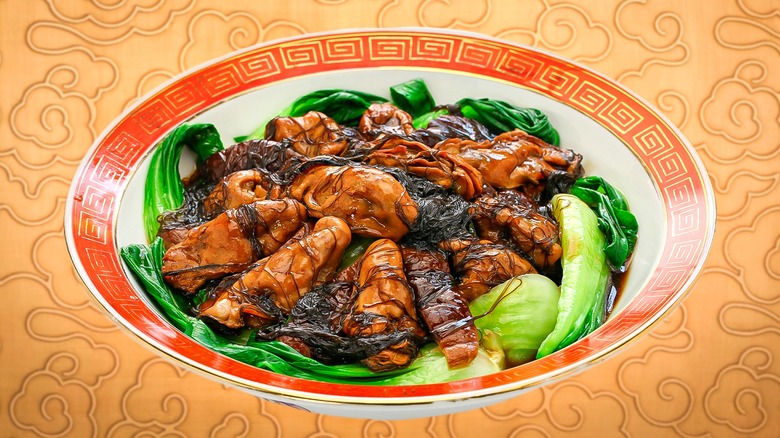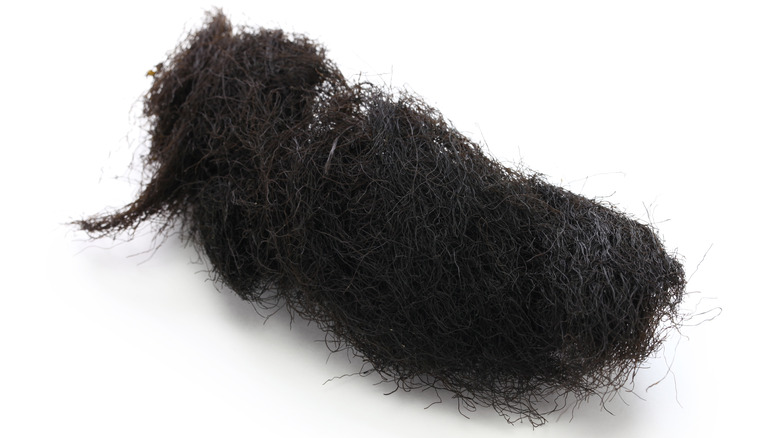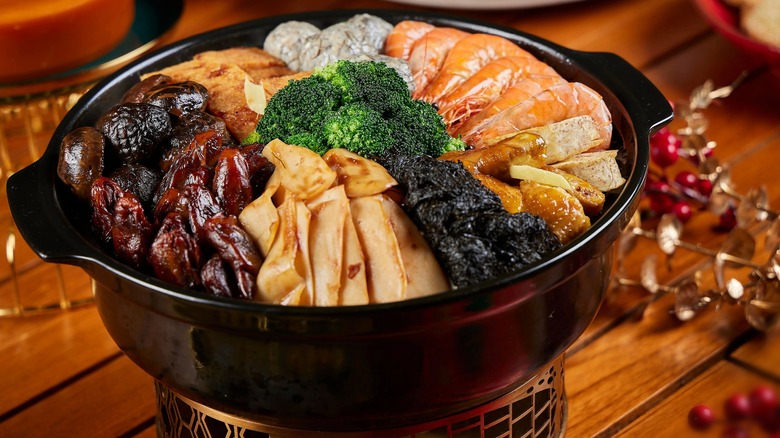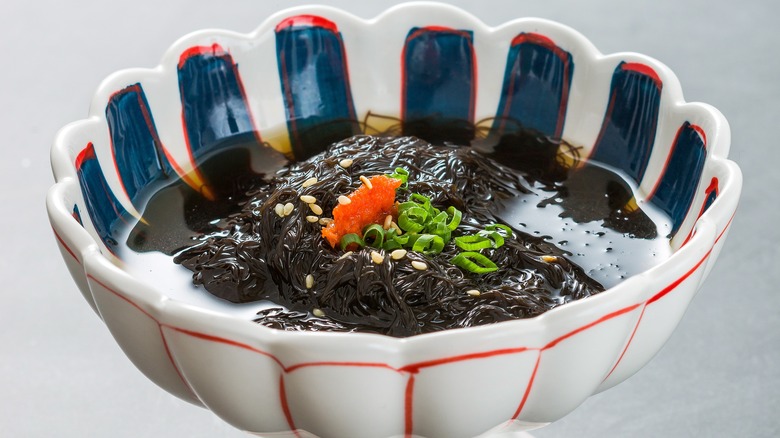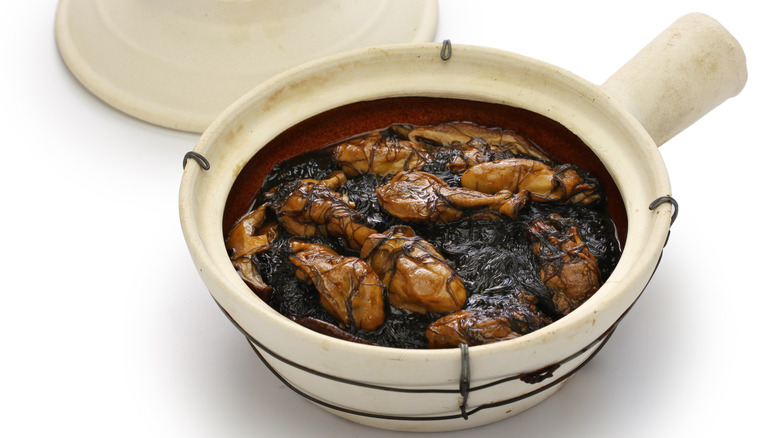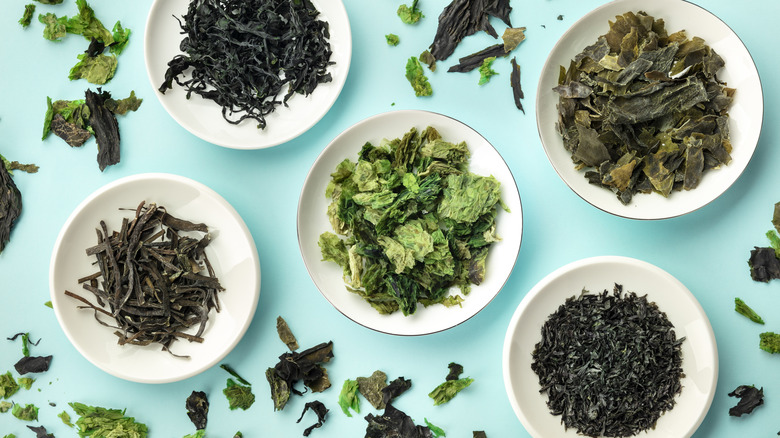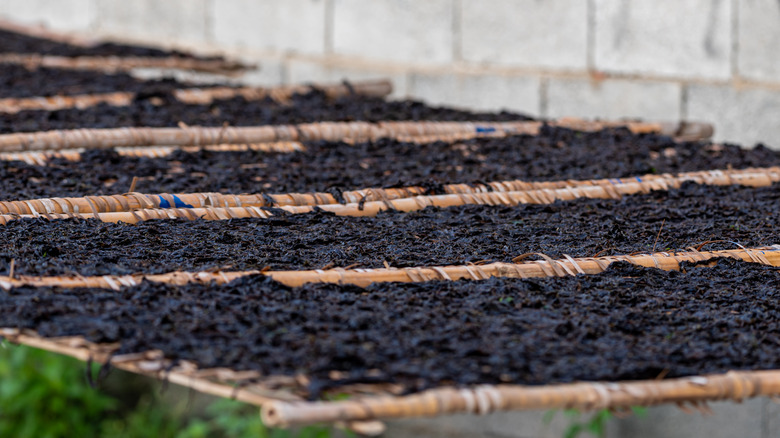Fat Choy: 9 Facts You Need To Know About This Chinese New Year Staple
Translating Chinese to English can create plenty of confusion for the grammarian and spellchecker alike. But regardless of whether you're pronouncing the traditional Lunar New Year greeting as "gung hay fat choy" or "kung hei fat choi," your well wishes will still get across. What also comes clearly across is fat choy, the food inadvertently mentioned every time you wish someone a Happy New Year. Fat choy is central to Chinese New Year, and not just because of a name game. Sure, there are a lot of other foods to prepare, as Chef Jonathan Wu shows with his hot pot delights, but regardless of the many dishes that can ring in the new year with style, from pomegranates to pickled herring, no Lunar New Year is complete without fat choy.
For some, this sea vegetable might be a little intimidating at first glance. These little dried, gray fuzzballs certainly bear no resemblance to foods that may be more familiar (and, arguably, more appetizing) to Western eyes. Certainly, the show-stopping rice desserts garnished with dates and nuts look much more appealing. If this is your first approach to fat choy, let's chew the fat on this hair-raising plant with facts gleaned from personal experience and confirmed with some online digging. By knowing the ins and outs of how to identify, prep, and cook it, you'll be gung-ho about fat choy's place in Chinese culinary culture.
Fat choy is not a plant
For foodies familiar with Chinese cuisine, fat choy might sound like some sort of bulky bok choy, the leafy green veggie that's prepped in a variety of ways. Alas, fat choy isn't fat at all. In fact, it looks the exact opposite of what that English word might suggest. For those expecting traditional Asian veggies, like bok choy or gai lan (Chinese broccoli), get ready for a surprise. Fat choy has no leaves and isn't even green.
Sometimes referred to as algae, moss, or seaweed, fat choy is found in certain parts of China. Its scientific name is Nostoc flagelliforme and, per the Journal of Microbiology and Biotechnology, it's a kind of cyanobacteria classified as terrestrial, meaning that it won't be found in the ocean. Rather, it's harvested on land, either in the wild or on farms. It might seem a bit unusual to chow down on these thin filaments we might find spouting from the wet ground, but seaweed and algae are actually rising superfoods, and numerous types of tasty seaweed can be cooked and served in dishes from soups to stir-fries.
For Chinese diners, fat choy isn't an everyday food. It's one of several vegetables served for the Lunar New Year and other special occasions, like family reunions. As a ritual food, fat choy has symbolic value to help people start the year with their best foot forward.
It symbolizes good fortune
Sometimes, food and fate can mix together to create something with iconic cultural significance. Fat choy is a perfect case of how a little play on words can give an otherwise regional dish a prominent place in the international lexicon. In Mandarin and Cantonese, the name fat choy literally translates to "hair vegetable," and it'll come as no surprise once you see this dish in its final form. Out of the package, fat choy can resemble a dark dust ball that, frankly, looks like it came from a used vacuum cleaner bag. However, when cooked, the dried, curled clumps of fat choy straighten out to resemble a mass of strands of flowing black hair.
During the Lunar New Year, the "fat choy" in the spoken Chinese greeting means "good fortune." The similar pronunciation to its name gives fat choy symbolic value representing good fortune for the coming year. As a good luck charm, fat choy isn't alone. Plenty of traditional Chinese dishes also symbolize good fortune, from specific types of fish that represent good luck to the whole chickens served for Lunar New Year feasts. While these meats have symbolic value, fat choy stands out with a name that phonetically sounds like a wish of good luck and, for this reason alone, it holds a prominent place on the menu.
Fat choy has historic roots in gambling
Fat choy represents good fortune, but a deeper dive into Chinese history and culture can complicate this meaning. While most people like to link greater financial success with hard work, for some Chinese, sudden riches are less about punching in a time clock and more about the thrill when getting lucky and winning a game.
Gambling and games of chance have a long history in Chinese culture, and the phrase "fat choy" has an implicit historic meaning of striking it rich through luck rather than hard work. In the 19th century, foreigners in China translated "Gung Hay Fat Choy" as an equivalent to "Congratulations on getting rich," which they associated with the money in festive red envelopes that elders would give to children. Fast forward to today, and you'll still find gambling houses packed during Chinese New Year, bustling with mahjong players and blackjack dealers, all hoping that the next hand will be the lucky one.
Food plays a heavy role in making the big time. Sure, you can spend the Lunar New Year dining at Disneyland, but for many Chinese, the happiest place on Earth might not be with Mickey and friends. Rather, gamblers might try their luck at a multi-day fiesta in Las Vegas, filled with money trees, casino parades, and, of course, well wishes for fat choy. This is one case where what happens in Sin City might come home when you cash out.
Fat choy is very expensive
When shopping for fat choy for the first time, it's best to do a little research first. Just browsing for fat choy can reveal a bewildering range of varieties and prices. A glance at Amazon shows that fat choy ranges from $10 to $15 per ounce. That means a pound can easily go up to three digits, so it's good to know in advance which brands give you the most for your bucks.
The best way to get familiar with fat choy is to inspect it yourself. Cities with large Asian populations are likely to have Asian supermarkets, where this vegetable should be readily available. One such place is H-Mart, which transformed Asian cuisine by making imported ingredients more accessible.
However, just because the package is imported doesn't make it authentic. Real fat choy is expensive due to its scarcity, so the market is flooded with counterfeit fat choy, such as vermicelli soaked in iodine. You can generally tell genuine fat choy from the fake stuff by its color; dried fat choy has a greenish-blue hue that turns black when cooked while artificial fat choy is always black. Unfortunately, China's food safety standards are not as rigorous as the FDA in the U.S., and even some Chinese customers don't trust what's on sale. If you come across fat choy with a price tag that seems too good to be true, chances are it won't bring you the fortune you're looking for.
It can have a lengthy prep time
Making a New Year's feast takes all day, especially if starting from scratch. A family might make a variety of foods to serve, as well as hanging lanterns, passing red envelopes, and getting ready for community celebrations. If you're in a hurry, the easiest way to prep fat choy is to simply soak it for 30 minutes before transferring it to a soup or stew pot. This one-and-done approach ensures the fat choy is thoroughly cooked and ready in time for the dragon parade.
A more careful method requires repeated soaking to get all the dirt and contaminants out. Unlike other soaked vegetables or grains, all sorts of dust and particles can be hidden in the gray, curled strands. If you're worried about artificial ingredients, as mentioned before, you might have to do an individual inspection of each strand to make sure that your fat choy is the real deal. The repeated rinsing out and soaking can easily extend the prep time for basic fat choy by several hours.
One tip to make the cleaning a little less of a chore is to use chopsticks to poke through your fat choy. Chopsticks can be more nimble than fingers and can save you time, energy, and eyesore when weeding the grit out of each strand. If you're making a more complicated dish, such as mixing fat choy with other vegetables like bamboo shoots or mushrooms, the prep times can be quite extensive.
Don't expect flavor
When you were younger, did you ever try chewing on your hair? If you don't remember or are curious, go ahead — no one's looking. Even if you use a scented shampoo or hairspray, chances are that you won't taste anything. Most likely, you'll get the unsettling sensation of having something inedible in your mouth. Fat choy, the hair vegetable, can provide much the same experience. On its own, it has no real taste, and biting down on a mouthful of the stuff is akin to moving a soggy mass around in your mouth. The hair-like texture can also be a bit hard to chew since you don't really mash it with your teeth. Instead, break it up into smaller clumps and swallow.
To make the taste much more palatable, some cooks immerse their fat choy in soups or oils so the strands can soak up some of the broth's umami flavor. Chicken stock or canola oil works well for starters, and you can sprinkle in some light seasoning. However, if the texture and taste (or lack thereof) is still a hurdle after that first swallow, don't toss the delicacy out. Check out some ideas below for taking your prepared fat choy to the next level.
Use fat choy as a topper or side dish
Fat choy's tastelessness makes it a poor choice for a main course but, with a little imagination, it can make an excellent topper or side dish. The most traditional way of prepping fat choy as a side dish is to simmer it with preserved mushrooms or dried oysters. The dried veggies will need to be cleaned and rinsed prior to cooking, which will also help rehydrate them. For your mushrooms, fat choy pairs well with several East Asian varieties, such as shitake or jian shou qing. You can either stir-fry the oysters and mushrooms first to bring out the umami before mixing in the fat choy, or simply simmer the vegetables with the fat choy in a broth. Either way, these ingredients will infuse their earthy scents and flavors into the fat choy. Feel free to add additional seasonings and oils; for a stir-fry, oyster sauce is particularly good at giving a savory, salty tang to welcome your new luck and fortune.
While the tried and true traditional approaches to fat choy remain standard in many New Year's dinners, you can also indulge your creative side. Fat choy's thin texture and lack of flavor can make it a blank canvas for the imagination. You can substitute shredded cabbage and lettuce with fat choy in your spring rolls or pot stickers, or add it as a topping to your glass noodle stir-fries and century egg salads.
This vegetable has dubious nutritional value
Eat your veggies. They're good for you. We've heard this expression a thousand times. However, fat choy might fall through the cracks in terms of providing nutrients and vitamins. Sure, it can symbolize a massive windfall of good luck heading our way, but what is wealth without health? Fortunately, seaweed and algae are often considered superfoods, for their nutritional value. According to Powing, fat choy also has strong properties to boost blood circulation, reduce high blood pressure, and help alleviate constipation and phlegm. Plus, it's naturally low in fat and cholesterol, so you can't go wrong there.
However, not all foodies agree that fat choy lives up to its hype. A study published in the journal ALS points out that samples of fat choy contain traces of beta-N-methlamino-L-alanine (BMAA), a toxic amino acid with a tongue-twisting name that has been linked to neurological diseases that attack our cognitive functions. This may be a cause for alarm, but keep in mind that not all fat choy on sale carries any BMAA, in part because so much fat choy circulating the markets is fake. Furthermore, the delicacy isn't an everyday dish, so trace amounts might not be as harmful as the study suggests. Still, this might be one instance where, if gambling with fat choy, getting the cheap stuff can pay off in the long run.
What is the future of fat choy?
Fat choy has a long history in Chinese culture. It's ironic, then, that fat choy harvesting has been banned in China for over two decades. The reason is that fat choy has been over-cultivated, which has ruined the environment in many parts of the country's northwestern provinces.
While seaweed can be a sustainable crop, the demand for fat choy in China has led farmers to overextend their fields to raise crops. Fat choy is a fickle vegetable and, as Quartz mentions, growers need as much as 16 football stadiums' worth of land to grow just 100 grams of the stuff — this amounts to about one handful of strands. This has gradually led to depleted soil, erosion, and heavy desertification of already dry regions. While officials in Beijing have limited fat choy cultivation, driving up the price, it's still readily available for diners, even if much of it is now fake.
Fortune favors the bold, and this can include expanding our palate. While fat choy may convey a prediction for future wealth headed our way, we should be wary that prosperity may come at a high price for both the environment and our health. Just as many would avoid shark fin soup, another controversial Chinese delicacy, we can observe the Lunar New Year while being mindful of what's on the dinner table.
